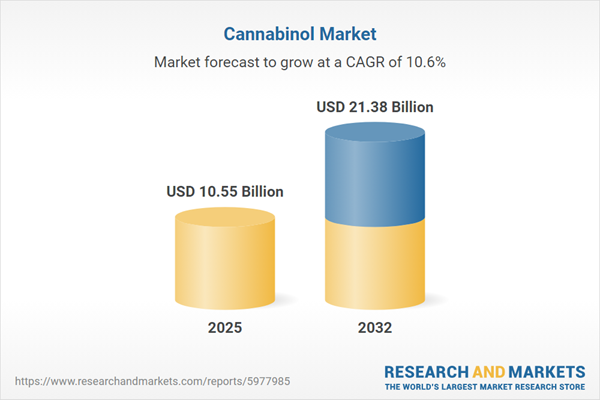Speak directly to the analyst to clarify any post sales queries you may have.
The global cannabinol market is experiencing rapid transformation, marked by evolving regulatory frameworks, technological innovation, and growing complexity across value chains. For senior decision-makers, understanding these dynamics is critical to sustaining operational resilience, capturing growth opportunities, and managing risk as the sector matures.
Market Snapshot: Cannabinol Market Outlook
Between 2024 and 2025, the global cannabinol market expanded from USD 9.57 billion to USD 10.55 billion, reflecting a compound annual growth rate (CAGR) of 10.56%. This upward momentum is set to continue, with the sector projected to reach USD 21.38 billion by 2032. Market growth is fuelled by heightened consumer and institutional interest and reinforced by substantial investments that are advancing product innovation. The increasing importance of regulatory compliance drives industry stakeholders to enhance tailored solutions, ensuring strategic positioning amid ongoing shifts in governance and standards.
Cannabinol Market Scope & Segmentation
A clear understanding of the cannabinol market’s scope is essential for identifying optimization and investment priorities. Key segmentation areas define competitive strategies, operational frameworks, and technology adoption.
- Product Types: The landscape includes capsules, distillates, isolates, tinctures, balms, creams, and salves. These varied offerings enable firms to serve both healthcare providers and wellness-focused consumers, supporting diverse use cases and encouraging innovation across segments.
- Packaging Solutions: Blister packs, bottles, and pouches are vital for maintaining product integrity, meeting compliance mandates, and enhancing visibility in commercial and retail environments.
- End Users: Demand is shaped by healthcare professionals, research institutions, adult consumers, and seniors. Their unique needs drive new product formulations and differentiated market approaches.
- Distribution Channels: Direct sales, e-commerce platforms, retail pharmacies, and specialized health outlets each bring distinct access considerations and regulatory requirements, framing accessibility and positioning outcomes.
- Key Applications: Primary applications span anxiety reduction, stress management, appetite regulation, pain relief, and sleep optimization. Solutions are tailored to address changing health priorities and niche therapeutic needs.
- Regional Coverage: The report comprehensively assesses markets in the Americas, Europe, Middle East & Africa, and Asia Pacific. Each region’s regulatory climate shapes compliance models, market entry, and broader risk management strategies.
- Company Coverage: Benchmarking of AURORA CANNABIS INC., CHARLOTTE’S WEB, INC., and Elixinol Wellness Limited provides perspective on leading partnership frameworks, acquisition initiatives, and evolving competitive moves.
Key Takeaways for Senior Decision-Makers
- Expanding product formats enables alignment with evolving customer preferences and sector standards, helping organizations build versatile cannabinol market portfolios that address emerging and niche needs.
- Focusing on cannabinoid-terpene profiles advances quality and regulatory compliance, particularly for health-centric solutions where consistent product performance reinforces stakeholder trust.
- Investments in biosynthetic production and advanced chromatography increase supply chain efficiency and resiliency, offering adaptability as regulations develop and transparency expectations rise.
- Strengthening collaboration with research partners and cross-functional teams accelerates product validation cycles, streamlining innovation and smoothing new market introductions.
- Emphasis on clear labeling and flexible compliance strategies supports stakeholder confidence, easing entry into both established and developing markets as regulatory frameworks evolve.
Tariff Impact on Cannabinol Supply Chains
Recent adjustments to U.S. tariff policies have prompted companies to reexamine their supply chain structures. Building stronger domestic cultivation, nurturing reliable local supplier relationships, and implementing blockchain-based traceability are reinforcing supply chain integrity. These measures not only uphold standards and regulatory compliance but also help mitigate logistical risks and safeguard continuous operations amid shifting global and regional dynamics.
Methodology & Data Sources
The insights presented are drawn from executive interviews, targeted end-user feedback, comprehensive regulatory analysis, proprietary trade data assessment, and market forecasting models. This integrated approach ensures the cannabinol market research provides relevant, validated intelligence to support strategic leadership and robust operational planning.
Why This Report Matters
- Supports timely adaptation to regulatory changes and paves the way for innovation and expansion in both established and emerging cannabinol markets.
- Delivers actionable frameworks for supply chain optimization and strategic risk management, enabling sharper positioning and improved response to evolving industry demands.
- Guides assessment of partnership opportunities and capital investment, equipping organizations to navigate operational risks and capitalize on sector developments.
Conclusion
Strategic adaptability, in-depth regulatory awareness, and rigorous monitoring empower senior leaders to navigate industry shifts and strengthen operational foundations in the cannabinol sector.
Additional Product Information:
- Purchase of this report includes 1 year online access with quarterly updates.
- This report can be updated on request. Please contact our Customer Experience team using the Ask a Question widget on our website.
Table of Contents
3. Executive Summary
4. Market Overview
7. Cumulative Impact of Artificial Intelligence 2025
Companies Mentioned
The companies profiled in this Cannabinol market report include:- AURORA CANNABIS INC.
- CHARLOTTE'S WEB, INC.
- CV Sciences, Inc.
- Diamond CBD
- Elixinol Wellness Limited
- ENDOCA.
- Etz Hayim Holdings, SPC
- Folium Biosciences Europe B.V.
- Fresh Bros Hemp Company
- Gaia Herbs, Inc.
- Green Roads
- GVB Biopharma
- High Labs International Inc.
- Isodiol International Inc.
- KND Labs
- Medical Marijuana, Inc.
- Medterra CBD, LLC
- NuLeaf Naturals, LLC
- Pharma Works LLC
- PharmaHemp d.o.o.
- Red Mesa Science & Refining, LLC
- Shaman Botanicals LLC
Table Information
| Report Attribute | Details |
|---|---|
| No. of Pages | 181 |
| Published | November 2025 |
| Forecast Period | 2025 - 2032 |
| Estimated Market Value ( USD | $ 10.55 Billion |
| Forecasted Market Value ( USD | $ 21.38 Billion |
| Compound Annual Growth Rate | 10.5% |
| Regions Covered | Global |
| No. of Companies Mentioned | 23 |









